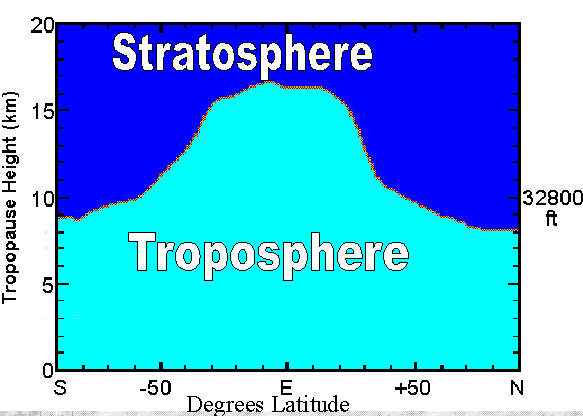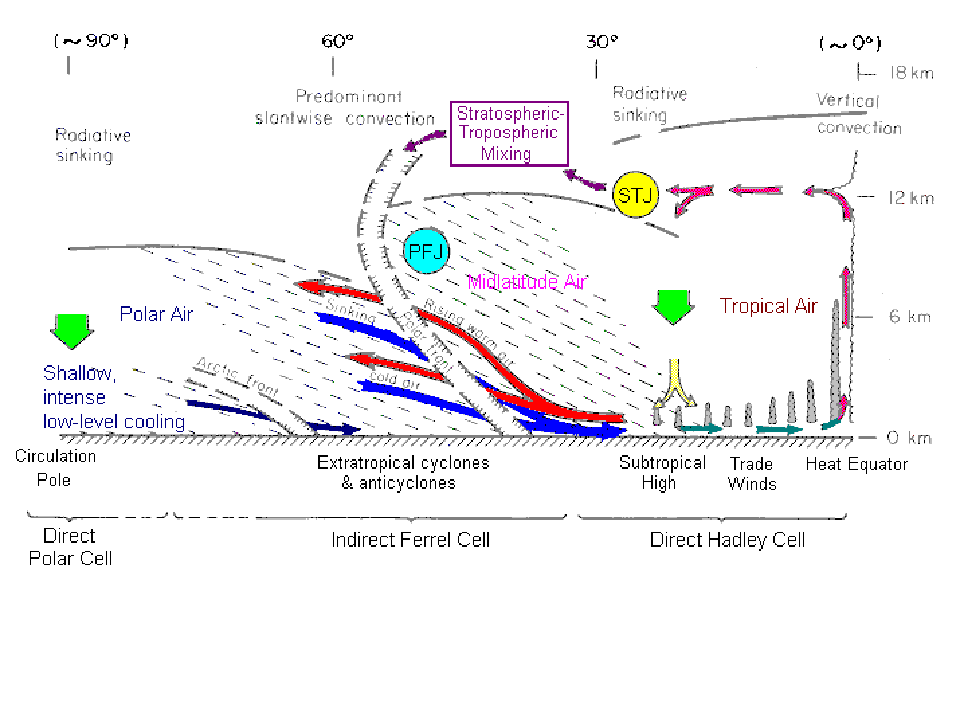The height of the tropopause
|
B. Geerts and E. Linacre |
11/'97 |
 The
height of the tropopause depends on the location, notably the latitude, as
shown in the figure on the right (which shows annual mean conditions). It also
depends on the season (1, 2). Thus, it is about 16 km high over Australia at
year-end, and between 12 - 16 km at midyear, being lower at the higher
latitudes. At latitudes above 60° , the
tropopause is less than 9 -10 km above sea level; the lowest is less than 8 km
high, above Antarctica and above Siberia and northern Canada in winter. The
highest average tropopause is over the oceanic warm pool of the western
equatorial Pacific, about 17.5 km high, and over Southeast Asia, during the
summer monsoon, the tropopause occasionally peaks above 18 km. In other words,
cold conditions lead to a lower tropopause, obviously because of less
convection.
The
height of the tropopause depends on the location, notably the latitude, as
shown in the figure on the right (which shows annual mean conditions). It also
depends on the season (1, 2). Thus, it is about 16 km high over Australia at
year-end, and between 12 - 16 km at midyear, being lower at the higher
latitudes. At latitudes above 60° , the
tropopause is less than 9 -10 km above sea level; the lowest is less than 8 km
high, above Antarctica and above Siberia and northern Canada in winter. The
highest average tropopause is over the oceanic warm pool of the western
equatorial Pacific, about 17.5 km high, and over Southeast Asia, during the
summer monsoon, the tropopause occasionally peaks above 18 km. In other words,
cold conditions lead to a lower tropopause, obviously because of less
convection.
Deep convection (thunderstorms) in the Intertropical Convergence Zone, or over mid-latitude continents in summer, continuously push the tropopause upwards and as such deepen the troposphere. This is because thunderstorms mix the tropospheric air at a moist adiabatic lapse rate. In the upper troposphere, this lapse rate is essentially the same as the dry adiabatic rate of 10K/km. So a deepening by 1 km reduces the tropopause temperature by 10K. Therefore, in areas where (or at times when) the tropopause is exceptionally high, the tropopause temperature is also very low, sometimes below -80° C. Such low temperatures are not found anywhere else in the Earth's atmosphere, at any level, except in the winter stratosphere over Antarctica.
On the other hand, colder regions have a lower tropopause, obviously because convective overturning is limited there, due to the negative radiation balance at the surface. In fact, convection is very rare in polar regions; most of the tropospheric mixing at middle and high latitudes is forced by frontal systems in which uplift is forced rather than spontaneous (convective). This explains the paradox that tropopause temperatures are lowest where the surface temperatures are highest.
 The
tropopause height does not gradually drop from low to high latitudes. Rather,
it drops rapidly in the area of the subtropical and polar front jets (STJ and
PFJ respectively in the Figure on the left), as shown in the Palmen-Newton
model of the general circulation (Fig 12.16 or Fig on left). Especially when
the jet is strong and the associated front at low levels intense, then the
tropopause height drops suddenly across the jet stream. Sometimes the
tropopause actually folds down to 500 hPa (5.5 km) and even lower, just behind
a well-defined cold front. The subsided stratospheric air within such a tropopause
fold (or in the less pronounced tropopause dip) is much warmer than the
tropospheric air it replaces, at the same level, and this warm advection aloft
(around 300 hPa) largely explains the movement of the frontal low (at the
surface) into the cold airmass, a process called occlusion (Section 13.3) (4).
The
tropopause height does not gradually drop from low to high latitudes. Rather,
it drops rapidly in the area of the subtropical and polar front jets (STJ and
PFJ respectively in the Figure on the left), as shown in the Palmen-Newton
model of the general circulation (Fig 12.16 or Fig on left). Especially when
the jet is strong and the associated front at low levels intense, then the
tropopause height drops suddenly across the jet stream. Sometimes the
tropopause actually folds down to 500 hPa (5.5 km) and even lower, just behind
a well-defined cold front. The subsided stratospheric air within such a tropopause
fold (or in the less pronounced tropopause dip) is much warmer than the
tropospheric air it replaces, at the same level, and this warm advection aloft
(around 300 hPa) largely explains the movement of the frontal low (at the
surface) into the cold airmass, a process called occlusion (Section 13.3) (4).
A frontal system is followed by a Rossby wave trough in th upper troposphere (Note 13.B), in other words such a trough corresponds with tropopause dip. An example of a wintertime tropopause map over North America shows at least two such dips. These dips are associated with Rossby wave troughs and therefore vorticity maxima (click and check out upper left map), and consequently frontal lows at the surface (lower left map). Generally the deeper the tropopause dip (or fold), the more intense the associated frontal disturbance.
References
(1) Sturman, A.P. & N. Tapper 1996. The Weather & Climate of Australia and New Zealand (Oxford) 476pp.
(2) Crutcher, H.L. 1969. Temperature & humidity in the troposphere. In Rex 1969, 45-84 (3).
(3) Rex, D.F. (ed) 1969. Climate of the Free Atmosphere. (World Survey of Climatology, Elsevier) 4, 450pp.
(4) Hirschberg, P.A. and J.M. Fritsch, 1991. Tropopause undulations and the development of extratropical cyclones. Part II: Diagnostic analysis and conceptual model. Mon. Wea. Rev., 119, 518-550.